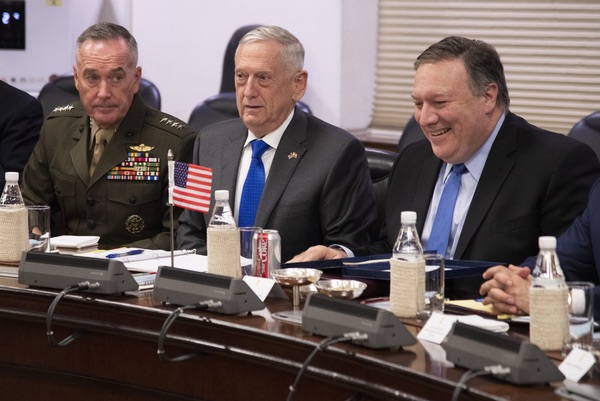Pompeo and Mattis should add space cooperation to the US-India strategic partnershipby Frank Rose and Jonathan Ward
|
| The US and India should focus on three avenues in space cooperation: industry, security, and diplomacy. |
As the world’s two largest democracies, the United States and India have long-term interests that will guide the relationship over the coming decades. Some of these interests include shared values, Indo-Pacific security and commerce, the US-India economic relationship, and an expansionist China that threatens both Indian interests in the Indian Ocean region and US interests in the Pacific.
The US and India should also discuss the next frontier: outer space.
The United States will need major power space partners in an era of strategic competition with Russia and China, and India could find no better partner for its objectives in space than the United States.
The United States and India have a strong record of space collaboration already, from a NASA-ISRO Mars Working Group to a successful Indian launch last year that brought 96 US satellites into orbit. India is already a significant space power: one of only four nations to have reached Mars’ orbit. Additionally, it is currently planning its first huamn spaceflight by 2022, making India part of an exclusive club, along with the United States, Russia, and China, to reach have reached this milestone. But much can still be done to integrate space into the broader US-India strategic partnership.
The US and India should focus on three avenues in space cooperation: industry, security, and diplomacy.
Industry cooperation presents many opportunities. The American private sector space industry is revolutionizing access to space. Advantages in private space industry give America an edge over India’s traditional space partner, Russia, which has little to no private space industry. As India works to build its own private sector space industry, with Bangalore-based startups leading the way, American firms may find serious benefits in working with this nation, with whom America’s long-term interests are aligned. Collaboration between US and Indian private space companies as part of a broader nation-to-nation strategic concept can complement cooperation between the US and Indian civilian space agencies.
| The United States and India can provide a unique alternative to China’s initiatives by working together, a move which would amplify the diplomatic power of both nations in critical regions across the globe. |
The US and India are already cooperating on a wide range of military projects, and began a formal dialogue on space security issues late in the Obama administration. The US and India should expand on those initial discussions. This is of particular importance given both India and the United States share concerns about China’s military buildup. Indeed, in testimony before Congress earlier this year, US Director of National Intelligence Dan Coats stated that China is continuing to pursue anti-satellite weapons as a means to reduce US and allied military effectiveness. An ever-more-modern Indian military would likely be subject to the same space-based vulnerabilities as the United States. Furthermore, Chinese advances in space-based surveillance and reconnaissance could provide China an edge in a potential conflict. Given this shared strategic concern, US-India cooperation should address space security in order respond to China’s growing capabilities.
Space diplomacy is an ever more important piece of the international security picture. Scores of countries now have their own space programs. The United States must work to shape new norms in space, particularly as Russia and China advance their own brands of space diplomacy. India would be an outstanding partner, especially given its long-standing relationships and appeal to many emerging nations. China’s “Belt and Road Initiative,” an intercontinental infrastructure project which has raised concerns in both India and the United States, now includes a “Belt and Road” in space. China plans to build extensive space infrastructure and is busy appealing to developing countries as a partner for access to space. The United States and India can provide a unique alternative by working together, a move which would amplify the diplomatic power of both nations in critical regions across the globe.
This presents an excellent opportunity to set long-term goals for the US-India strategic partnership. In an era of great power competition, cooperation between the world’s two largest democracies must be a strategic imperative. And cooperation in outer space should be a key element of that partnership.
Note: we are temporarily moderating all comments subcommitted to deal with a surge in spam.
